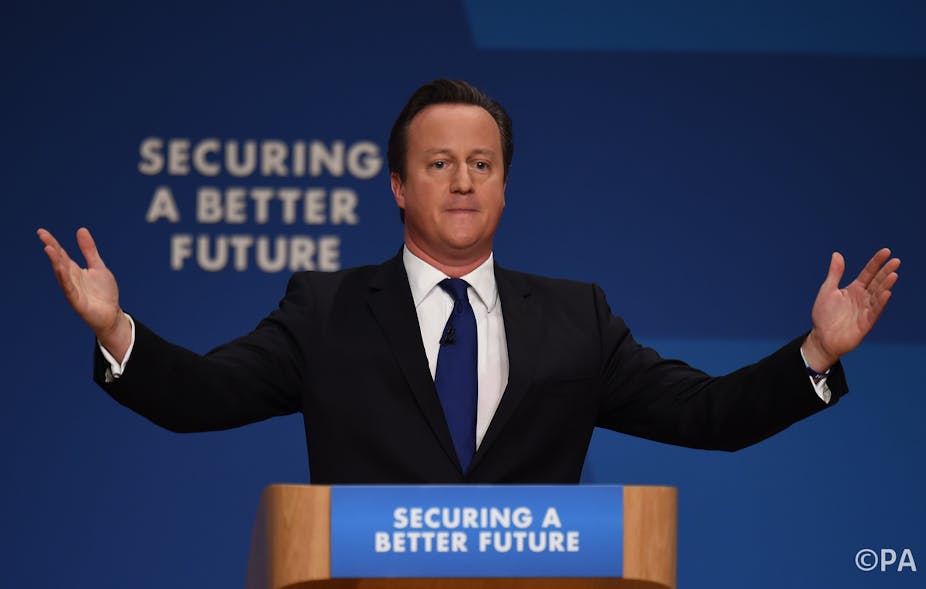Is it possible for the voting public to learn something about their leaders just from watching the body language they display when they speak in public? Given the number of obviously rehearsed gestures made by both David Cameron and Ed Miliband as they made their respective party conference speeches, they must both be banking on it.
Batoning gestures are natural vertical hand gestures performed in time with verbal stresses and both Cameron and Miliband gave us plenty of these. Their hands could regularly be seen shaped in carefully studied positions. Sometimes both Cameron and Miliband held their hands in a fist with the thumb over the top and other times they placed their thumb and fingers in a purse position. Both of these hand positions are taught to politicians for a very good reason. They are trained to adopt these gestures in order to avoid more weapon-like positions, such as pointing index fingers that jab and stab the air. Gone are the days of Gordon Brown nervously rearranging his paperwork during speeches; all major politicians are now trained to be televisual from head to toe.
Cameron and Miliband were well-prepared, displaying their parties’ planned poses as they spoke. Cameron and the Conservatives chose a commanding style of leadership, while Miliband and Labour aimed to present a more open style of leadership.

Miliband was notably speaking without a podium with part of the audience behind him – although he did not turn to address them. This was a bold choice as it left him in a very exposed position. Instead of creating distance between himself and the people he was addressing, he was surrounded. He had to move around much more than Cameron, who stuck to traditional positioning behind a lectern, facing his audience.
Miliband’s openness also appeared in his hand positions. In many cases when his hand was open, his fingers were spread out, while Cameron’s finger positions were often more natural and less spread. For example, when batoning in a cat’s cradle position, Miliband’s fingers are spread abnormally far apart. Miliband naturally looks open because of his big open eyes and large mouth, which the media recently compared to the gormless look of Wallace from Aardman Animation’s Wallace and Gromit series.

A podium adds power and distance to a speaker, and Cameron’s traditional pose behind a podium was more closed, especially when he was deliberately looking angry. Cameron’s deep set eyes, small mouth and thin lips have a natural predisposition toward appearing petulant, and Cameron’s speaking style leans heavily upon this anger to put across an air of determination and steadfastness.

When belittling the Labour party for the NHS Stafford Hospital scandal, he projected this stern, parental anger to warn Labour: “Don’t you dare lecture anyone about the NHS again”. This and other angry moments in his speech were typically accompanied by a dagger-like forefinger gesture that suggests an aggressive attitude.
At one point, Cameron even joked about a photo of him topless on the beach in Cornwall, and said: “People will ask have we got what it takes [to build a land of opportunity] … I’ve got the stomach for the fight.” It seems paradoxical to say that one may be clear in being indirect, but the body language that accompanied this joke and other comments was perfectly transparent. The prime minister showed meticulously stage-managed domination. His success in projecting this image was proved the moment he ordered the audience to give a standing ovation to Britain’s soldiers. Without hesitation, the crowd was on its feet as if Birmingham had suddenly become the final scene of an American feel-good movie.
What they didn’t want you to see
But alongside these sculpted poses, both party leaders leaked some information about themselves that they probably hoped you wouldn’t notice.

Miliband usually kept his hands close to his vertical mid-line, avoiding extremes of left and right. And on several occasions his hands came protectively together in front of his abdomen. This suggests some anxiety, although it is hard to tell if this related to his struggles as a leader or just the a result of the strange set up in which he found himself, flanked on all sides by onlookers in a talk-show style gathering with no podium to protect him.

His hands often assumed another central position, steepling in front of his abdomen, which is a sign of technical confidence. This position is often seen in engineers and experts, and is even reminiscent of Miliband’s brother David. In some ways, though, Miliband’s tendency to position his hands centrally is a defensive mechanism. They are the hands of a geek in the playground, worried that a bully is about to kick a football at him.

Cameron’s most revealing gesture is found in his face. His thin lips regularly purse inward at certain times in a particularly idiosyncratic way. Thinning lips are typically a sign of anger but the inward movement of Cameron’s lips, as if he was about to bite his lip, is actually a sign of anxiety. Before becoming Conservative leader, Cameron was known for having a fear of public speaking. He used to blush uncontrollably in front of a crowd but has managed to control that sign of anxiety. His lip movements reveal that his anxiety still hasn’t been completely vanquished though.
These two leaders are different in so many ways and their body language tells us what kind of prime minister they are, or would be. Many of their actions and positions on stage are well-rehearsed but others are impulsive. All confirm that Miliband is open while Cameron is commanding. Their bodies give away tell-tale signs of nerves while public speaking, but neither gave off signs that they are unfit for the job of leader. Cameron is evidently an aggressive presence in Downing Street but if Miliband were to be elected, we could expect him to exert more technocratic control.

